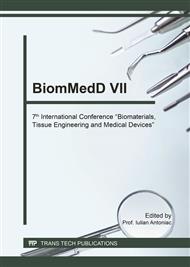[1]
D.W. Kim, E.S. Yoon, B.I. Lee, et al., Fracture depth and delayed contour deformity in frontal sinus anterior wall fracture, J Craniofacial Surg, 23 (4) (2012) 991–994.
DOI: 10.1097/scs.0b013e31824dfcb1
Google Scholar
[2]
M.S. Sakat, K. Kilic, E. Altas, et al., Comminuted frontal sinus fracture reconstructed with titanium mesh, J Craniofacial Surg, 27 (2) (2016) e207–208.
DOI: 10.1097/scs.0000000000002466
Google Scholar
[3]
S. Manolidis, Frontal sinus injuries: associated injuries and surgical management of 93 patients, Journal of Oral and Maxillofacial Surgery, 62 (7) (2004) 882-891.
DOI: 10.1016/j.joms.2003.04.020
Google Scholar
[4]
O. Egemen, O. Ozkaya, T. Aksan, et al., Endoscopic repair of isolated anterior table frontal sinus fractures without fixation, J Craniofacial Surg, 24 (4) (2013) 1357–1360.
DOI: 10.1097/scs.0b013e3182902518
Google Scholar
[5]
E. Bradley Strong, Frontal sinus fractures Operative Techniques in Otolaryngology, Head and Neck Surgery, 19(2) (2008) 151-160.
DOI: 10.1016/j.otot.2008.08.001
Google Scholar
[6]
M Misra, M. Dujovny, G. Gonzales-Portillo, C. Abood, Cranial Titanium Osteosynthesis Systems, Surgical Neurology, 48(6) (1997) 632-635.
DOI: 10.1016/s0090-3019(97)00336-4
Google Scholar
[7]
W. Marshall Guy, Anthony E. Brissett, Contemporary Management of Traumatic Fractures of the Frontal Sinus, Otolaryngologic Clinics of North America, 46(5) (2013) 733-748.
DOI: 10.1016/j.otc.2013.07.005
Google Scholar
[8]
I. Antoniac, Handbook of Bioceramics and Biocomposites, Springer International Publishing, New York (2016) 1275-1307.
Google Scholar
[9]
M. Dumitru, D. Nica, A. Mohan, B. Feder, A.V. Ciurea, New concept in cranioplasty based on biomaterials performance in various clinical cases, Key Engineering Materials, 695 (2016) 185-188.
DOI: 10.4028/www.scientific.net/kem.695.185
Google Scholar
[10]
A. Mohan, V. Saceleanu, D. Mohan, A. V. Ciurea, Value of Dural Patches in Obliteration of Cranio-Ethmoidal Traumatic CSF Fistulas, Key Engineering Materials, 695 (2016) 196-199.
DOI: 10.4028/www.scientific.net/kem.695.196
Google Scholar
[11]
C. Shuo-Tsung, C. Cheng-Jen, S. Wei-Chin, C. Lin-Wan, C. I-Hsuan, L. Muh-Shi, 3-D titanium mesh reconstruction of defective skull after frontal craniectomy in traumatic brain injury, Injury, 46(1) (2015) 80-85.
DOI: 10.1016/j.injury.2014.09.019
Google Scholar
[12]
W. Marshall Guy, Anthony E. Brissett, Contemporary Management of Traumatic Fractures of the Frontal Sinus, Otolaryngologic Clinics of North America, 46(5) (2013) 733-748.
DOI: 10.1016/j.otc.2013.07.005
Google Scholar
[13]
J.R. Vignes, N.O. Jeelani, M. Dautheribes, F. San-Galli, D. Liguoro, Cranioplasty for repair of a large bone defect in a growing skull fracture in children, Journal of Cranio-Maxillofacial Surgery, 35(3) (2007) 185-188.
DOI: 10.1016/j.jcms.2007.04.002
Google Scholar
[14]
B.C. Brevi, A.S. Magri, L. Toma, E. Sesenna, Cranioplasty for repair of a large bone defect with autologous and homologous bone in children, Journal of Pediatric Surgery, 45(4) (2010) e17-e20.
DOI: 10.1016/j.jpedsurg.2010.01.011
Google Scholar
[15]
M. A Stoodley, J.R. Abbott, D. A Simpson, Titanium cranioplasty using 3-D computer modelling of skull defects, Journal of Clinical Neuroscience, 3(2) (1996) 149-155.
DOI: 10.1016/s0967-5868(96)90009-0
Google Scholar
[16]
J.J. Wind, C. Ohaegbulam, F.M. Iwamoto, P.M. Black, J.K. Park, Immediate Titanium Mesh Cranioplasty for Treatment of Postcraniotomy Infections, World Neurosurgery, 79(1) (2013) 207. e11-207. e13.
DOI: 10.1016/j.wneu.2011.02.013
Google Scholar
[17]
N. Kirkpatrick, Facial and orbital injuries, Surgery (Oxford), 24(1) (2006) 37-42.
Google Scholar
[18]
M.F. Patel, J.D. Langdon, Titanium mesh (TiMesh) osteosynthesis: a fast and adaptable method of semi-rigid fixation, British Journal of Oral and Maxillofacial Surgery, 29(5) (1991) 316-324.
DOI: 10.1016/0266-4356(91)90118-o
Google Scholar
[19]
N. Rosen, B.R. Brady, T.J. Buonanno, E.S. Kistler, J.P. Hinshaw, S. Waldo et al, Potential hazards and artifacts of ferromagnetic and nonferromagnetic surgical devices in nuclear magnetic resonance imaging, Radiology, 147 (1982) 139–148.
DOI: 10.1148/radiology.147.1.6828719
Google Scholar
[20]
M.P. Martin, S. Olson, Post-operative complications with titanium mesh, Journal of Clinical Neuroscience, 16(8) (2009) 1080-1081.
DOI: 10.1016/j.jocn.2008.07.087
Google Scholar
[21]
E.T. Talvan, M.I. Fagetean, C. Mohor, M. V. Saceleanu, Management of frontal sinus trauma associated with orbital roof and nasal bone fracture – Case Report and review of the literature, Acta Medica Transilvanica, 21(1) (2016) 85-88.
Google Scholar
[22]
A.A. Magliocco, Therapeutic means in frontal fractures, International Journal of Oral and Maxillofacial Surgery, 36(11) (2007) 1081-1082.
DOI: 10.1016/j.ijom.2007.08.452
Google Scholar


